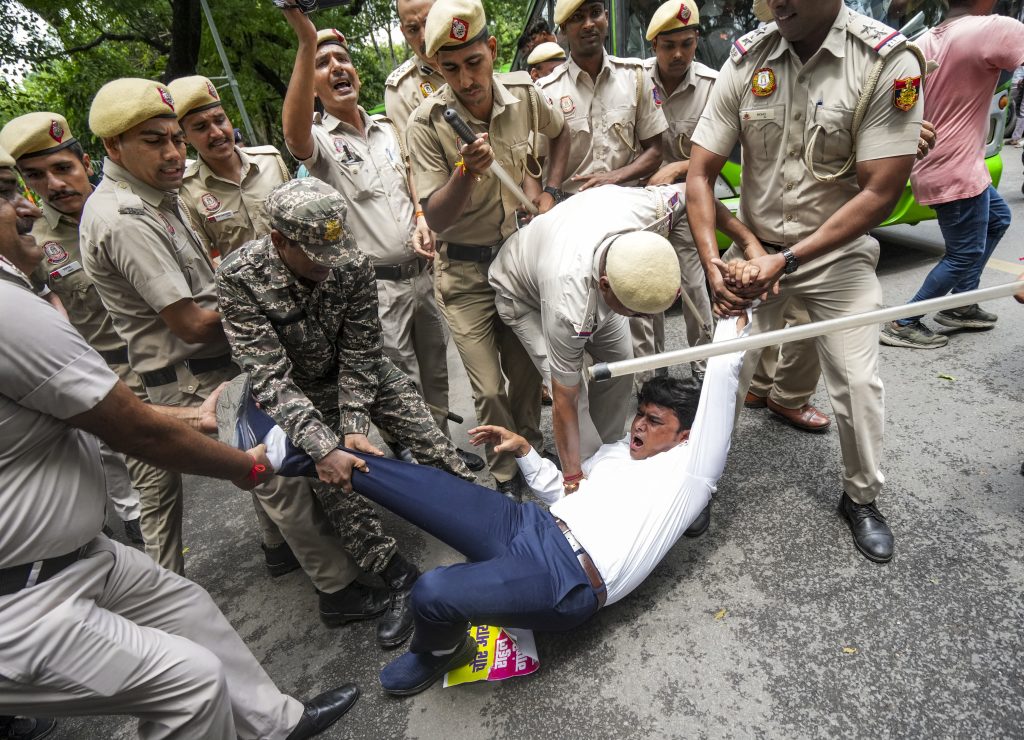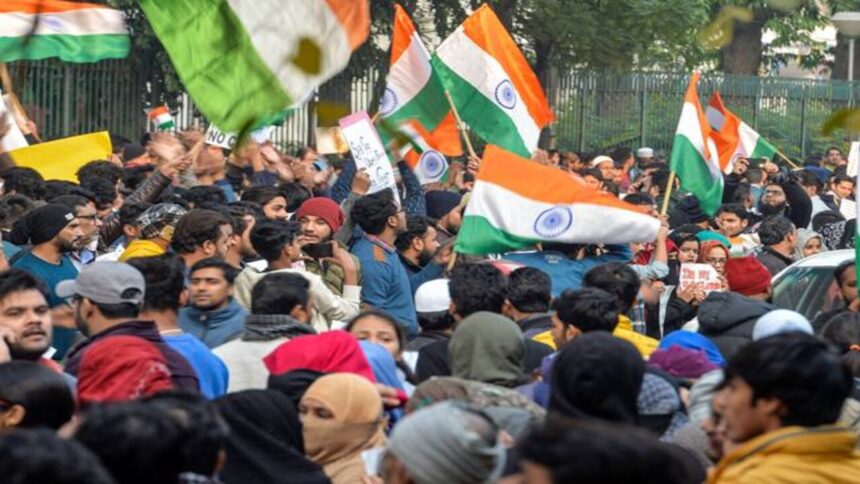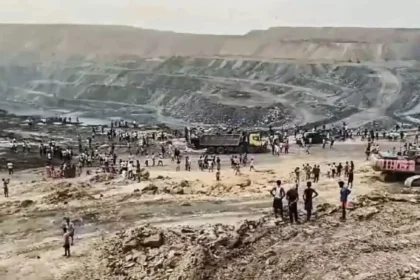10 Decades of Dissent: How Delhi’s Streets Became the Epicentre of India’s Protest Power
On a winter night in Delhi, beneath the shadow of a flyover, women wrapped in shawls sit shoulder to shoulder. They are grandmothers and homemakers, holding the constitution in one hand and prayer beads in the other. They sing, they cook, they teach their children as traffic swerves away. Shaheen Bagh, an invocation of equality and belonging in the face of the Citizenship Amendment Act, is not planned by leaders or scripted by parties; it is conjured out of desperation, held together by voices often unheard. For three months in 2019 and 2020 it becomes the republic’s conscience, until the pandemic arrives as an ally of power and dissolves it. The women went home. The law they resisted endured.
A year later Delhi bears witness to another kind of protest. The highways leading into the city become barricaded towns, inhabited not by the forgotten but by those who feed the nation. Farmers from Punjab and Haryana dig borewells into asphalt, build kitchens that never close, stock libraries in the open air. They endure the heat, the dust, and the winter cold for a year.
They hold their discipline even when the government tries to discredit them, branding them as extremists, some leaders calling them ‘Khalistanis’, summoning a ghost from the violent 1980s. Yet they hold their nerve when the state waits them out. In the end, it is the prime minister who retreats. On live television, Narendra Modi announces that the farm laws will be repealed.
Two movements of comparable scale: one iconic but ineffectual, the other decisive, distil the history of protest in India since independence. Protest does not prevail by numbers alone. It endures when it fractures the powerful, spills beyond its own boundaries, and finds the cracks through which institutions still let light in. For most of India’s history, those levers clicked together often enough to bend the state because elites bent first; tycoons, industrialists, bureaucrats peeling away. In Modi’s India, they stand still, arms folded, eyes averted. Absence hardens into complicity.
The story of how the street once shaped the state begins in the fragile years of the republic. The Telangana peasant revolt, already smouldering when independence arrived, was met with troops and suppression. But when Tamil students rose against the imposition of Hindi in the 1960s, setting themselves on fire and filling the skies with smoke from burning buses, Delhi relented. English would remain, a concession that preserved federal balance and transformed the politics of Tamil Nadu. Elsewhere, the same readiness to bend was revealed in Kerala when the first elected Communist government was dismissed in 1959 after church-led agitations made its survival untenable.
These early episodes announced a truth that would echo through decades: dissent could be crushed when it stood alone, but when it resonated with electoral peril or elite anxiety, it altered the course of power.
By the 1970s, protest had become both weapon and threat. The railway strike of 1974 brought over 1.5 million workers onto the tracks, paralysing the nation. But the absence of allies left it exposed, and it was broken by arrests and sackings. That same year, a call for ‘Total Revolution’ spread across the north, carried by students and unions. Indira Gandhi met it with the Emergency, suspending liberties and filling prisons. For two years the streets were silenced. Yet when elections were restored in 1977, the suppressed anger roared back through the ballot, and she was toppled. Protest had been contained, but its embers burned long enough to ignite a transfer of power.
The years that followed showed how movements could stretch across decades. In Assam, agitation against undocumented migrants lasted six long years, with violence that scarred the state, until Delhi signed the Assam Accord in 1985. Elsewhere, far from Assam’s turbulence, a quieter revolution gathered among Dalits in Maharashtra and Uttar Pradesh. Mobilisations drew on Ambedkar’s legacy to demand dignity and recognition, planting the seeds of parties that would later reshape caste politics. In Punjab, by contrast, demands for Khalistan curdled into militancy and were met with the full force of the state. The line between protest and insurgency, once crossed, was answered with arms.
In the 1990s, the republic was jolted by Mandal and Mandir. The announcement of OBC reservations brought waves of student immolations, yet the policy survived, and caste arithmetic redrew India’s political map. The Ram Janmabhoomi agitation, culminating in the demolition of the Babri Masjid, was not a negotiation with the state but a mobilisation that reshaped the polity itself, unsettling alliances and rewriting the grammar of power. At the same time, rights-based movements found new avenues.
The Narmada Bachao Andolan fought dams with satyagraha and international campaigns; it slowed but could not stop them. The Right to Information campaign, born in Rajasthan villages, grew into a national demand and by 2005 had prised open the workings of government through law. For the first time, the republic’s opacity was forced into the light by those it governed.
The new millennium carried this spirit forward. In West Bengal, farmers at Singur and Nandigram resisted land acquisition, driving Tata Motors out and, eventually, the Left Front from power. Their defiance was not a moment but a siege: villages turned into barricades, fields defended as fiercely as borders. In Telangana, years of marches and hunger strikes accumulated like pressure in a sealed chamber until, at last, a new state was born.
In Delhi, Anna Hazare’s fast against corruption pulled the middle class into the street, tents multiplying on Ramlila Maidan until a new party carried its momentum into power. And a year later, the gang rape of a young woman on a Delhi bus ignited protests that forced swift legal reforms. From village squares to urban avenues, protest remained the second republic; untidy, improvisational, but still capable of bending law and toppling governments.
When Modi arrived in 2014, those traditions still seemed intact. Protest still carried the memory of villages that had defied bulldozers, of hunger strikes that had broken parliaments, of vigils that had forced law to move. But very soon the ground begins to close. NGOs that once linked the village to the capital find their arteries severed as the Foreign Contribution Regulation Act is tightened, smaller groups fold, networks collapse, the bloodstream of dissent bled out. Corporate and legacy media, once amplifiers of protest, crawl into kennels of cheerleaders, their lapdog instincts honed.
Only scattered pockets of independent outlets still keep their vigil, small lamps guttering against the wind. Their voices remain brave but increasingly confined, throttled by lawsuits and intimidation. And the internet, once hailed as protest’s great amplifier, becomes a master switch, snapped off at will in Kashmir, Manipur, Haryana, plunging whole movements into a silence that feels like suffocation. Protest does not vanish, but its pathways constrict into corridors where breath itself is hard to find. Hashtags flare like sparks: bright for a night, then gone. Breadth, not virality, decides whether protest endures. The state knows this, which is why it kills the signal at the crowd’s edge.
The logic that follows this silencing is always self-serving. The state’s frame is simple and neat: protests become anarchic, dissent becomes violence, and therefore force is justified. In Ladakh, Sonam Wangchuk urged non-violence, yet a cropped clip turned his words into incitement, and he was jailed after clashes left bodies on the ground. In Delhi, Umar Khalid explicitly asked protesters not to meet hate with hate, yet edited footage was used to brand him the “mastermind” of riots, keeping him behind bars for years without trial. In both cases, alleged provocation is dwarfed by the state’s response; lethal force in one, prolonged incarceration in the other.
Peaceful dissent is recast as threat. It is the state that answers with violence. And once dissent is retooled as menace, the rest of the apparatus moves in step: courts, police, prisons, each playing its role in the choreography of containment.
The persistence of Hindi as a fault line reveals how older struggles resurface under new guises. Half a century after students burned buses in Madras, chanting Hindi Ozhiga, Tamil Vazhaga (Down with Hindi, long live Tamil), resistance simmers again as Delhi nudges Hindi into national exams, military recruitment, signage, and bureaucratic protocols. The National Education Policy’s emphasis on ‘mother tongue plus Hindi’ sounds innocuous but is read in the south as imposition by stealth. Every crowd carries its ghosts: the flames of Madras in 1965, the silence of the Emergency, the vigils of Shaheen Bagh.
They march again in new forms, reminding Delhi that memory does not fold away as easily as tents. Protests in Tamil Nadu today may lack the flames of the 1960s, but the memory of fire remains close to the surface, reminding Delhi that language wars never truly end.
Shaheen Bagh remains the emblem of this new era: visually arresting, morally powerful, globally covered, yet unable to compel change. Its virality spreads across social media, but without elite fractures or institutional allies it stays isolated. If seven decades teach anything, it is that breadth outlasts hashtags, timing matters more than fury, and institutions decide whether the street leaves only an echo or an imprint. The farm encampments that follow reveal what is still possible.
Their breadth cuts across rural north India; their discipline keeps them alive for a year; and their timing coincides with looming elections. These are the old levers still at work in a new political landscape, a momentary crack in a newly fortified state, and they force Modi to concede. But the rarity of that reversal underscores how exceptional it has become.
Other mobilisations – Patidar quotas in Gujarat, Dalit outrage in 2018, Agnipath recruits burning trains, wrestlers demanding justice – rise and fall without shaking the government. Federal colour matters: farmers are shielded by sympathetic states, while Patidars in Gujarat are smothered by a hostile one. Where opposition parties embrace protests, as in West Bengal, they topple regimes. Where they do not, the state endures.
The Modi era also reveals protest’s new amplifier abroad. Diaspora communities march in London, Toronto, New York, carrying placards in solidarity with farmers and with Shaheen Bagh. Pro-government NRIs answer in kind, bolstering legitimacy, and India’s democracy is thrust into global headlines. Yet Delhi turns even this to its advantage, framing criticism as interference, draping censure as proof of strength. In the end, the pressure of foreign capitals seldom shifts outcomes.
Meanwhile, in the borderlands, protest is smothered before it can speak. In Kashmir, the valley after August 2019 falls into a silence enforced by curfews and communications blackouts. No marches, no slogans, just the weight of an unbroken shutdown. In Manipur, the state burns in ethnic violence through 2023 and 2024, while the internet is cut for months. The absence of visible protest in these places is not peace but suffocation, a reminder that silence, too, is political.
The Vote Chori protests of 2025 are the sharpest test yet. They allege that the mechanics of democracy itself, machines, apps, audits, have been compromised. It is always the young who light the first fires; students in Madras, railway apprentices in 1974, university hostels chanting in 1990. And today, the cry of Vote Chori is carried first by voices barely old enough to have voted at all.
Their gatherings are smaller than the farmers’, less resonant than Shaheen Bagh, but they carry a different charge: the charge of illegitimacy. On Delhi’s avenues and in provincial towns, demonstrators hold aloft placards that read mera vote chori hua, my vote was stolen. The chant does not tire; it insists. Less fury than Mandal, less theatre than Mandir, but more dread; for it suggests that the very instrument by which citizens hold rulers accountable has been hollowed out.

There is resolve in these marches, a restlessness that refuses to be quieted. Some compare them to Shaheen Bagh, destined to be remembered more for imagery than effect. Others recall the Right to Information campaign, slow and grinding until suddenly it reshaped the republic. And some whisper of a movement dismissed at first as irrelevant, until its call toppled Mrs Gandhi. Vote Chori may yet prove to be one of those moments that looks like defeat in its hour but alters the future. If the ballot is bent and the street smothered, where does legitimacy go? How long can a republic that distrusts its crowds still pretend to claim consent?
From Tamil students burning buses in 1965 to women under a flyover in 2020, from marchers silenced by the Emergency to farmers building cities of resistance on Delhi’s highways, India’s second republic has always been written in the street. That republic is weaker today, throttled by law, surveillance, and silence. Yet history suggests the street never disappears. It waits. The repeal of the farm laws showed the barricade can still be broken. The Vote Chori protests will decide whether that moment was a fluke or the start of another chapter.
A democracy this vast cannot survive on ballots alone. Delhi’s fate still lies with India’s crowds. It always passes through the crowd, through its silences and its storms, through its long patience and its sudden surges. And when the street truly moves, no state, not even Delhi, however strong, has yet found the gut to stand against it.
Also Read: Syrians Vote in Indirect Polls for First Post-Assad Parliament








